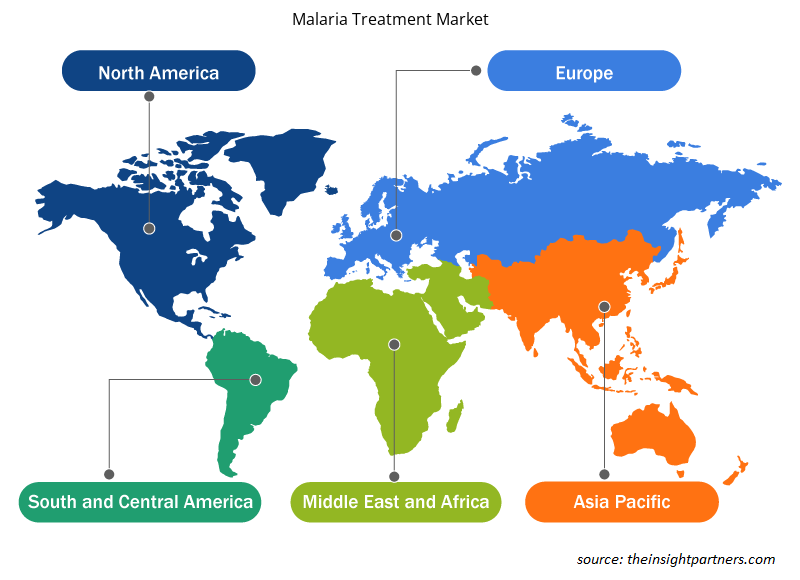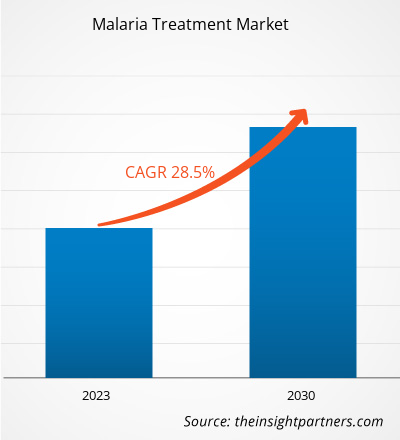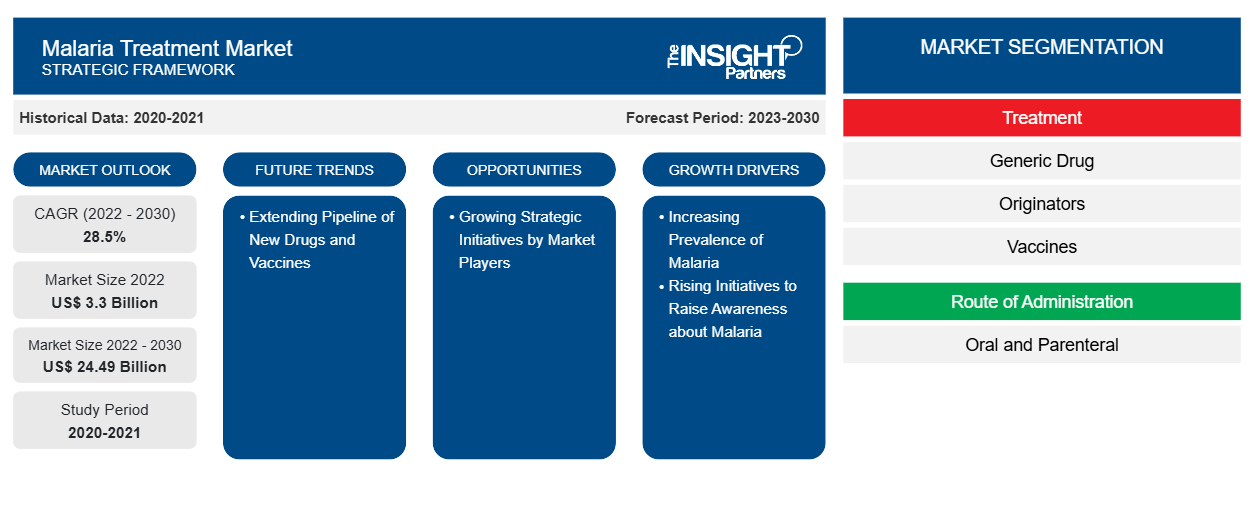[研究报告] 2022年疟疾治疗市场价值为 32.9698 亿美元,预计到 2030 年将达到 244.8773 亿美元;预计 2022 年至 2030 年的复合年增长率为 28.5%。
市场洞察和分析师观点:
疟疾是一种由疟原虫引起的危及生命的传染病。由于低收入国家疟疾患病率高,以及国际和国家组织发起的全球疟疾消除计划,疟疾治疗市场正在增长。此外,先进诊断工具的不断推出和为提供有效治疗方法而开展的研究活动的不断增加,正在推动疟疾治疗市场的增长。在大流行的两个高峰年(2020-2021 年),与 COVID 相关的干扰导致超过 1300 万例疟疾病例和 63,000 例相关死亡。世卫组织非洲区域继续承担着全球疟疾负担的巨大份额。2021 年,非洲约占所有疟疾病例的 95% 和死亡人数的 96%。此外,5 岁以下儿童占该地区所有疟疾死亡人数的约 80%。据同一消息来源称,尼日利亚、刚果民主共和国、坦桑尼亚联合共和国和尼日尔占全球疟疾死亡人数的一半以上。
增长动力和挑战:
疟疾是一种急性发热性疾病,由疟原虫引起,通过受感染的雌性按蚊传播。人类主要有五种寄生虫导致疟疾,其中两种——恶性疟原虫和间日疟原虫——被认为是对人类健康的最大威胁。此外,恶性疟原虫是最致命的疟疾寄生虫,在非洲大陆传播最为广泛。此外,间日疟原虫是撒哈拉以南非洲以外大多数国家的主要疟疾寄生虫。根据世界卫生组织 (WHO) 最新的《2020 年世界疟疾报告》(WMR),全球报告了 2.41 亿例疟疾病例,而 2019 年记录的病例为 2.27 亿例。根据同一来源,疟疾造成的死亡人数每年增加 69,000 人。其中约三分之二(即 47,000 人)的死亡是由于 COVID-19 疫情期间医疗服务中断造成的;其余三分之一(即 22,000 人)的死亡反映了世卫组织计算疟疾死亡率的方法最近发生了变化(不考虑 COVID-19 中断)。因此,全球不同地区疟疾患病率的上升推动了疟疾治疗市场的增长。
抗疟药物耐药性的发生可能是由于假药的供应和使用日益增多、某些预防药物的过度使用、活动性感染的治疗不彻底以及疟原虫在遗传和代谢水平上的适应性等原因造成的。假冒抗疟药物的使用增多是全球医疗保健部门面临的主要问题。由于医疗成本高昂,大多数非洲国家都广泛使用假冒抗疟药物。人们还选择使用假药以更低的成本接受治疗,而一些国家缺乏合理的质量控制和验证流程,从而为获取这些假药提供了便利。根据《媒介传播疾病杂志 2020》报道,假冒抗疟药物不仅造成经济损失,还降低了治疗效果,从而导致人们对医疗保健系统失去信心,并增加了疟原虫产生耐药性的可能性。
因此,假冒抗疟药的日益盛行阻碍了疟疾治疗市场的增长。
定制此报告以满足您的需求
您可以免费定制任何报告,包括本报告的部分内容、国家级分析、Excel 数据包,以及为初创企业和大学提供优惠和折扣
-
获取此报告的关键市场趋势。这个免费样品将包括数据分析,从市场趋势到估计和预测。
报告细分和范围:
根据治疗方法,疟疾治疗市场细分为仿制药、原研药、疫苗和其他。根据给药途径,疟疾治疗市场分为口服和肠外给药。根据分销渠道,疟疾治疗市场细分为直接招标、医院药房、零售药房、网上药房和其他。按地域划分,疟疾治疗市场细分为北美(美国、加拿大和墨西哥)、欧洲(英国、德国、法国、意大利、西班牙和欧洲其他地区)、亚太地区(中国、日本、印度、澳大利亚、韩国和亚太其他地区)、中东和非洲(沙特阿拉伯、阿联酋、南非、肯尼亚、坦桑尼亚、卢旺达、尼日利亚、加纳、乌干达、安哥拉、喀麦隆、塞内加尔、赞比亚和中东和非洲其他地区)以及南美洲和中美洲(巴西、阿根廷和南美洲和中美洲其他地区)。
节段分析:
根据治疗方法,疟疾治疗市场细分为仿制药、原创药物、疫苗和其他。2022 年,疫苗细分市场占据了最大的市场份额。此外,预计该细分市场在预测期内的复合年增长率最高。疫苗提供针对特定传染病的主动获得性免疫。由于研发活动不断增加以及候选疫苗渠道不断增加,疟疾疫苗市场正在以显着的速度增长。唯一获批的疟疾疫苗是葛兰素史克开发的 RTS,S 疫苗,用于防止恶性疟原虫进入肝脏。它需要注射四次,并通过撒哈拉以南非洲国家的国家免疫计划提供给幼儿。该疫苗是 2019 年开始的试点引入的一部分。国际和地方合作是疫苗开发不可或缺的一部分,到 2024 年试点推广结束时; RTS,S 的资助预计将超过 10 亿美元,其中 7 亿美元将由葛兰素史克公司提供,该公司已为该试点项目捐赠了 1000 万剂疫苗。
按给药途径,疟疾治疗市场分为口服和肠外给药。2022 年,口服部分占据了更大的市场份额。然而,预计肠外部分在预测期内的复合年增长率会更高。口服给药是最优选和最合适的给药途径,因为它具有较高的患者依从性、非侵入性、最少的无菌限制、成本效益、剂型设计的灵活性和制造过程的简易性。易于给药和长期成本效益等优势是推动口服药物采用的主要因素。药片、胶囊和其他口服药物的低制造成本也是疟疾治疗市场增长的关键驱动因素。一些可用的抗疟疾药物是奎宁、奎尼丁、氯喹、阿莫地喹、他非诺喹氯胍、氯丙胍和青蒿素。 ACT 和联合疗法用于治疗由恶性疟原虫引起的无并发症疟疾。ACT 是目前市场上最有效的抗疟药物。
根据分销渠道,疟疾治疗市场分为直接招标、医院药房、零售药房、在线药房和其他。2022 年,直接招标部分占据了最大的市场份额。此外,预计同一部分在预测期内也将录得最高的复合年增长率。招标是执行特定任务或以固定金额提供物品的要约。在此招标程序的第一步中,将要求承包商提交密封的施工投标或在特定期限内提供特别计划的服务或产品。印度的电子招标程序旨在确保及时完成政府或特定客户的工作。例如,一些地方可能有特定的采购法规,规定决策方式和接受哪些投标。例如,全印度医学科学院、比哈尔邦医疗服务和基础设施有限公司(比哈尔邦政府)、巴特那(AIIMS Patna)董事总经理邀请知名、经验丰富、财力雄厚的公司/企业/机构为印度不同的医疗机构竞标疟疾检测试剂盒和药物。
区域分析:
根据地理位置,疟疾治疗市场分为五个主要区域——北美、欧洲、亚太地区、南美和中美以及中东和非洲。北美市场的分析主要集中在三个主要国家——美国、加拿大和墨西哥。2022 年,中东和非洲占据了疟疾治疗市场的最大份额。可支配收入的增加、对有针对性的营养的需求不断增长以及对疟疾治疗和补充剂的认识不断提高是推动市场增长的一些主要因素。
尼日利亚的疟疾治疗市场占有最大的市场份额,沙特阿拉伯是预测期内增长最快的市场。根据严重疟疾观察站的报告,疟疾在尼日利亚非常突出,约 97% 的人口患疟疾的风险很高。此外,根据 2021 年世界疟疾报告,尼日利亚记录的疟疾病例数最多,死亡人数也最多,即 2020 年全球疟疾死亡人数的约 32% 发生在该国。为了克服如此高的疟疾流行率,尼日利亚与国家疟疾消除计划 (NMEP) 合作,在世卫组织的技术支持下启动了高负担高影响 (HBHI) 方法。
疟疾治疗市场机会:
市场参与者不断增加的战略举措
疟疾治疗市场中的一些主要参与者越来越注重采用各种策略,例如产品创新、发布和批准;研发投资;以及并购,以保持竞争力。下面提到了其中一些举措:
- 2022 年 3 月,用于治疗特定疟疾菌株的新型药物他非诺喹在澳大利亚获得疟疾药物研发基金会 (MMV) 的许可,该基金会与葛兰素史克 (GSK) 共同开发了这种用于儿童和青少年的药物。该药物与广泛使用的抗疟药氯喹结合使用。
- 2021 年 12 月,Zydus Cadila 宣布计划与 Medicines for Malaria Venture 合作开发其抗疟药 ZY19489,该药物已获得美国 FDA 批准。据该公司称,ZY19489 的 I 期试验表明,该药物半衰期较长,并且有可能单剂量治愈疟疾。在另一项疟疾挑战试验中,单次口服 ZY19489 后显示出强大的抗疟活性。
因此,市场参与者上述战略举措预计将为未来几年的疟疾治疗市场提供增长机会。
疟疾治疗市场区域洞察
Insight Partners 的分析师已详细解释了预测期内影响疟疾治疗市场的区域趋势和因素。本节还讨论了北美、欧洲、亚太地区、中东和非洲以及南美和中美洲的疟疾治疗市场细分和地理位置。

- 获取疟疾治疗市场的区域特定数据
疟疾治疗市场报告范围
| 报告属性 | 细节 |
|---|---|
| 2022 年市场规模 | 33亿美元 |
| 2030 年市场规模 | 244.9亿美元 |
| 全球复合年增长率(2022 - 2030 年) | 28.5% |
| 史料 | 2020-2021 |
| 预测期 | 2023-2030 |
| 涵盖的领域 |
按治疗
|
| 覆盖地区和国家 |
北美
|
| 市场领导者和主要公司简介 |
|
疟疾治疗市场参与者密度:了解其对业务动态的影响
疟疾治疗市场正在快速增长,这得益于终端用户需求的不断增长,而这些需求又源于消费者偏好的不断变化、技术进步以及对产品优势的认识不断提高等因素。随着需求的增加,企业正在扩大其产品范围,进行创新以满足消费者的需求,并利用新兴趋势,从而进一步推动市场增长。
市场参与者密度是指在特定市场或行业内运营的企业或公司的分布情况。它表明在给定市场空间中,相对于其规模或总市场价值,有多少竞争对手(市场参与者)存在。
在疟疾治疗市场运营的主要公司有:
- 西普拉有限公司
- 辉瑞公司
- 太阳制药工业有限公司
- 赛诺菲公司。
- 葛兰素史克公司
免责声明:上面列出的公司没有按照任何特定顺序排列。

- 了解疟疾治疗市场顶级关键参与者概况
竞争格局和重点公司:
全球疟疾治疗市场中的一些知名参与者包括 Cipla Ltd、Sun Pharmaceutical Industries Ltd、Sanofi SA、GSK Plc、Novartis AG、Pfizer Inc、Emmaus Life Sciences Inc、AdvaCare Pharma USA LLC、VLP Therapeutics LLC、Lupin Ltd 和 Teva Pharmaceutical Industries Ltd。这些公司专注于开发新技术、改进现有产品和扩大地理覆盖范围,以满足全球不断增长的消费者需求并扩大其专业产品组合范围。在全球疟疾治疗市场运营的公司正在实施各种无机和有机战略。下面提到了其中一些:
- 2022 年 11 月,诺华和抗疟药物研发基金会 (MMV) 宣布决定进入 3 期临床试验,研究一种新型非青蒿素组合药物,用于治疗无并发症的疟疾。这种新型组合药物还含有优化的卢米凡特林配方,可每天给药一次,而不是通常的每天给药两次。
- 2021 年 10 月,葛兰素史克公司 (GSK) 欢迎世卫组织建议更广泛地部署 GSK 的 RTS,S 疟疾疫苗,以减少儿童(生活在撒哈拉以南非洲和其他中度至高度传播地区)因疟疾而发病和死亡的人数。RTS,S 是第一个也是唯一一个在关键长期临床试验中被证明可以显著减少儿童疟疾发病率的疟疾疫苗。该疫苗是 GSK 与 PATH 和其他合作伙伴共同领导的 30 多年研究的成果。
- 历史分析(2 年)、基准年、预测(7 年)及复合年增长率
- PEST和SWOT分析
- 市场规模、价值/数量 - 全球、区域、国家
- 行业和竞争格局
- Excel 数据集
近期报告
客户评价
购买理由
- 明智的决策
- 了解市场动态
- 竞争分析
- 客户洞察
- 市场预测
- 风险规避
- 战略规划
- 投资论证
- 识别新兴市场
- 优化营销策略
- 提升运营效率
- 顺应监管趋势























 获取免费样品 - 疟疾治疗市场
获取免费样品 - 疟疾治疗市场